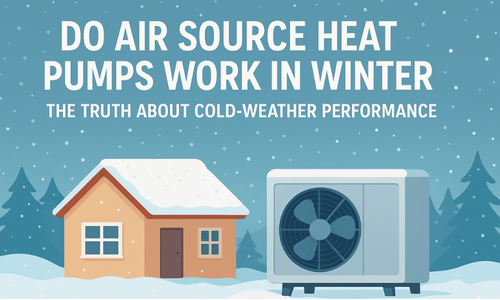Do Air Source Heat Pumps Work in Winter? The Truth About Cold-Weather Performance
- Lindo Mavuso
- Aug 21
- 3 min read

It’s a fair question — and one that stops many UK homeowners from making the switch. The idea of relying on outside air to heat your home in January sounds counterintuitive. But here’s the truth: a modern air source heat pump is designed to deliver reliable heating even when the mercury drops well below freezing. In this guide, we’ll explain exactly how these systems keep working in cold weather, what affects their efficiency, and how to make sure yours is set up for maximum comfort and cost-effectiveness all year round. By the end, you’ll know whether a heat pump is the right choice for your home this winter — and beyond.
How Heat Pumps Perform in Cold Weather
Let’s cut through the noise: a quality air to water heat pump doesn’t just survive winter — it’s built for it. Modern systems can still extract usable heat from the air in temperatures as low as -15°C, making them a solid choice for UK homes year-round.
The secret lies in the refrigerant cycle. The refrigerant inside your heat pump evaporates at a much lower temperature than water. That means even cold air holds enough energy for the system to absorb, compress, and transfer as heat into your home’s radiators, underfloor heating, and hot water cylinder.
In typical UK winter conditions (0°C to 7°C), most units maintain a COP (Coefficient of Performance) between 2.5 and 3.5. Put simply, for every unit of electricity used, you’re getting 2.5–3.5 units of heat — still far more efficient than gas or electric heating.
If you want to see exactly how installation works and how the setup affects performance, our Essential Guide to Air Source Heat Pump Installation walks you through the process step-by-step.
Factors That Affect Winter Efficiency
Not all air source heat pumps perform the same in winter. The difference between a system that keeps your home toasty and one that struggles comes down to a few key factors:
1. Insulation Quality Good insulation means less heat loss, so your pump doesn’t have to work as hard. If your walls, loft, and windows aren’t well-insulated, even the best system will be fighting an uphill battle.
2. Correct Sizing An undersized unit will constantly run to meet demand, while an oversized one can cycle inefficiently. An MCS-certified installer will size your system for your exact heating and hot water needs.
3. System Design A well-designed air to water heat pump works in harmony with your home’s heating system — whether that’s radiators, underfloor heating, or a mix of both.
4. Smart Controls & Weather Compensation Modern controllers automatically adjust heat output based on outdoor temperatures, improving efficiency during cold snaps.
Want to know if your home ticks the right boxes? Our guide, Is an Air Source Heat Pump Installation Right for Your Home?, covers it in detail.
Maximising Winter Performance
If you’re going to invest in an air source heat pump, you want it running at its best — especially when it’s cold outside. Here’s how to get maximum performance in winter:
1. Upgrade Your Insulation First Before installing, make sure your loft, walls, and floors are well-insulated. Less heat escaping means your pump works less and saves more.
2. Use the Right Heating Emitters Underfloor heating works brilliantly with heat pumps because it runs efficiently at lower temperatures. If you have radiators, you may need to consider upgrading to high-output models for better heat distribution.
3. Set Steady Temperatures Unlike boilers, heat pumps work best running consistently, not being turned on and off. Keep a steady set point for warmth and efficiency.
4. Maintain Your System A yearly service ensures your pump is clean, leak-free, and performing as it should — vital during peak heating months.
5. Leverage Smart Controls Weather-compensating thermostats adjust your system automatically based on outside conditions, keeping efficiency high.
For more on designing a system that works perfectly for your property, see our Air Source Heat Pump service page.
Conclusion: Winter Is No Obstacle
The idea that air source heat pumps can’t handle a UK winter is one of the biggest myths out there — and now you know it’s simply not true. With the right system design, proper insulation, and professional installation, a heat pump will keep your home warm, your water hot, and your energy bills under control, even when it’s freezing outside.
If you want a low-carbon, cost-efficient heating solution that works all year round, it starts with expert advice and a tailored plan for your home.
Don’t guess — get the facts for your property.Book your free survey with Puraflow Renewables today and discover how an air source heat pump can work for you this winter and beyond.



Comments